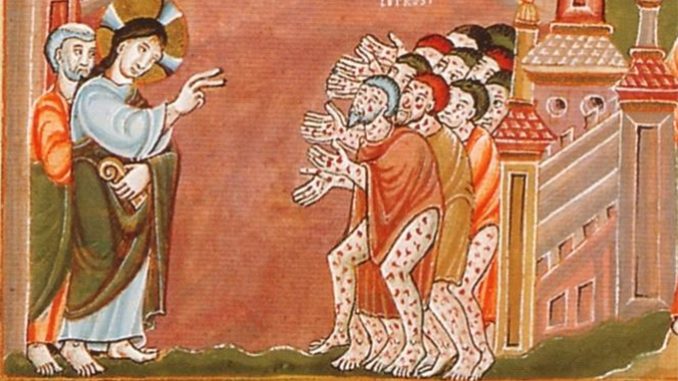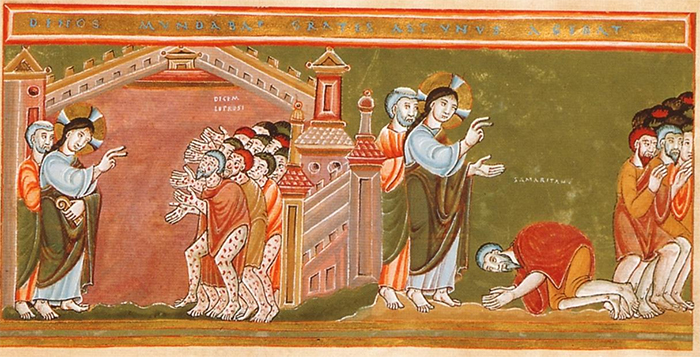
Readings:
• 2 Kgs 5:14-17
• Ps 98:1, 2-3, 3-4
• 2 Tim 2:8-13
• Lk 17:11-19
Zombies have long been a part of popular culture, with numerous movies and books presenting stories about the “living dead” (or “undead”) whose decaying bodies and grotesque features repulse and frighten healthy humans. They are the deadly outsiders who are a mortal threat to society; they are beyond hope, without any chance of being restored to real life.
Lepers were the “zombies” of the ancient Middle Eastern world, the “living dead” whose illness cut them off from the land of the living. What is called “leprosy” in the Bible included a wide range of skin diseases. In some cases, recovery was possible; in other situations, it was impossible.
The Law prescribed that “the leper who has the disease shall wear torn clothes and let the hair of his head hang loose, and he shall cover his upper lip and cry, ‘Unclean, unclean’” (Lev. 13:45). If a leper thought he was cured, he had to present himself to the priest, be sprinkled seven times with the blood of a bird, be bathed and shaved, separated from others for seven days, and then offer further sacrifices (Lev. 14).
That is notable because Naaman, the commander of the army of the Syrian king, was simply told by the messenger of the prophet Elisha to “Go and wash in the Jordan seven times” (2 Kgs. 5:10). Naaman angrily refused at first, unimpressed with the Jordan River compared to other, apparently greater rivers. He did not, Origen wrote, “perceive that it is our Jordan, and not the prophets, that removes the uncleanness of those who are unclean because of leprosy and heals them.”
The Jordan River is the most important river in Scripture, the boundary that Joshua crossed when entering the holy land, and the body of water in which Jesus was baptized when beginning his public ministry. As a symbol of salvation, it pointed to the sacrament of baptism, in which man—marked by the terminal illness of sin—is washed, purified, and made whole. When the Gentile Naaman was cured of leprosy, he recognized the uniqueness of the God of Israel and declared he would only offer sacrifices to him. In this acknowledgement of the God of Israel, Naaman pointed to a coming covenant meant for all peoples and nations.
That new and everlasting covenant is evident in today’s Gospel reading. Having just chastised the apostles for their lack of faith (Lk. 17:5-6), Jesus was met by ten lepers crying out, “Master!”—the only place in the Gospel of Luke that the title is used by a non-disciple. Jesus did not heal them on the spot, but told them to show themselves to the priest, as the Law required of those healed. In other words, he required them to take a step (or several steps) of faith, a command that surely made an impression on the apostles.
All ten were physically healed, yet only one returned, giving glory to God (as had Naaman) and falling at the feet of Jesus, an expression of humility and devotion. “You see,” wrote St. Athanasius about this thankful leper, “those who give thanks and those who glorify have the same kinds of feelings. They bless their helper for the benefits they have received.” Ten lepers had called Jesus “Master”, but only one of them showed that he really did believe that Jesus was Master and Lord.
It reminds us—as we say in the Liturgy of the Eucharist—that it is proper to give Him thanks and praise. The story also shows that while many of the Jews did not give thanks for the goodness of God, there were others, including the reviled Samaritans, who would and did. The lesson for the apostles, notes Luke Timothy Johnson, was that “they are not to expect thanks, but rather to give thanks to the one who has saved them.”
The repentant sinner, knowing he is the “living dead”, rejoices in the new life given by the Father, through the Son, in the Holy Spirit.
(This “Opening the Word” column originally appeared in the October 10, 2010, edition of Our Sunday Visitor newspaper.)

If you value the news and views Catholic World Report provides, please consider donating to support our efforts. Your contribution will help us continue to make CWR available to all readers worldwide for free, without a subscription. Thank you for your generosity!
Click here for more information on donating to CWR. Click here to sign up for our newsletter.







A QUESTION, here, about the nine lepers who did not return to give thanks…Have wondered for a long time if, in this case especially, familiarity breeds contempt? As outcasts, did the nine choose to resent the promise of healing from One within their own familiar Hebrew tribe?
DID they eventually say to themselves and to each other that they simply deserved as much, as (undeserving) outcasts? “Who is He, and who are these uppity priests, anyway?” Questioning, were they like so many who, in our own ultimate moment, dismiss the Lord’s final invitation to either go with Him, or not, and who say, instead, “I think I’ll just stick with what I know?” And, by this habitual and closed reflex, default themselves unhealed into solitary hell?
DID the lepers choose to not believe that they would be healed, by Another, and then not even show themselves to the priests? In that questioning space, did the nine choose to simply stay with familiar, societal- and shared self-contempt? Misery loves company. Were they ungrateful, choosing to stick with cabbage handouts, and to not be made whole by Another—as was rightfully (!) theirs all along? The Samaritan, did he choose otherwise—in humility of heart? Did he alone go to the priests and alone then return to give thanks?
Just wondering…. Is one purpose of the gifted SACRAMENTAL LIFE for us to be formed in the habit of saying yes; instead of hesitating later at our own final and ultimate moment?
Amen Carl.
Give thanks to the LORD, for he is good,his mercy endures forever.
PS 118:1-2
As to the thankful Samaritans Luke Timothy Johnson’s interpretation that the Apostles were not to expect thanks [apparently thanks for their service?], rather give thanks to God. Whereas the nine Jews seemingly, as the chosen, considered themselves entitled to healing, the lone Samaritan as a Samaritan did not, realized the gift.
Johnson’s insight is relevant elsewhere. That Jesus expected the Jews to show the same appreciation seems to speak to the sin of pride that was the bane of the Pharisees. It’s in our moment the bane of Catholic clergy who assume they’re owed praise for their service rather than consider themselves useless servants.